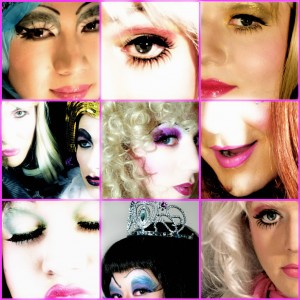By Elissa Frittaion
“We all come into this world naked. Everything else is drag.” ~ Ru Paul

Wikipedia states that drag, in its most general sense, means ‘any clothing one wears’. It is also used to refer to any costume that carries symbolic significance. This usually refers to the clothing associated with one gender role when worn by a person of the other gender. “Drag queen” first appeared in print in 1941. Typically, today, the term ‘drag queen’ refers to any person (usually male), gay or straight, who performs in campy, over the top dresses and shoes, huge wigs, extreme makeup etc. Drag queens sometimes impersonate female celebrities but also have their own persona, complete with a dramatic stage name. They sing, they lip synch, they dance and perform in shows.
Many Canadian cities host a pride parade at some point during June or July. Some are huge city wide festivals and some are smaller local marches. But there are a few things you are guaranteed to see at any pride parade, no matter where it is: balloons, dogs wearing rainbow bandanas, young men wearing nearly nothing at all, glitter, feathers, and drag queens. Some people are distressed by the participation of drag queens in pride parades, as they believe it enforces harmful stereotypes and impedes acceptance. But then there are others that regard that particular point of view as intolerant, and believe instead that the diversity of the gay community should be fully embraced. And then there are still others that feel that drag is simply a profession and an art form that need not be politically analyzed.
In the history of theater, it’s only recently that women have been permitted to perform on stage. Previously, all female parts were played by men in drag. This is where the first seeds were planted, but the first performances of drag as we know it today happened in the late 1800s. Since then, we have seen any number of drag queens portrayed on stage and screen, from Tony Curtis and Jack Lemmon upstaging Marilyn Monroe in Some Like it Hot, to the modern acerbic comedy routines of Eddie Izzard and Dame Edna. Most recently, the public was able to see ‘behind the makeup’ on Ru Pauls Drag Race, a competitive reality show for drag queens.
The makeup procedure for drag is quite intensive and can take hours. Most drag queens do their own makeup, and have a pretty solid routine down. As a makeup artist, I have done a number of these makeups and I find that when working on a man who does not typically do drag the makeup usually takes about 2 hours(extra time is used up minimizing his eyebrows and shaving all facial hair as closely as possible). Eyebrows are ‘blocked’ out with adhesive (I like a silicone based adhesive called Telesis 5, but have seen drag queens simply use a glue stick on their own brows), and foundation must be heavy, and colour corrected in certain areas in order to block out beard shadow. From there, it’s all about creating a character with makeup. Contouring is done to feminize the features (slimming the nose and jaw), new eyebrows are draw on above the real ones, and a huge eyelid is created with eyeshadow. False lashes, sometimes up to 3 or pairs, are applied and new lips are created that are much fuller than the real lips underneath. Gloss, glitter, rhinestones and other appliqués are all optional finishing touches.
The face of the queen, built on top of the face of the man, is always highly stylized. It is accompanied by hair pulled tight and flattened out under a hot, itchy wig. One must suffer to be beautiful, goes the old adage, and indeed, no one would claim that drag is comfortable. They cinch up those corsets and hoist up their assets and suffer in stilettos, like the glamorous screen sirens so many have impersonated. Monroe, Crawford, Minnelli, Garland, Dietrich … the list goes on. Actress Bette Davis, a longtime inspiration for drag queens, had been heard to say that she felt no one understood her as well the men who impersonated her on stage. In her later years, she was of course also famously quoted as saying “Old age ain’t for sissies.” Indeed. Neither is drag. But they are entertainers and professional all the way through, so they march those platforms out on stage and shake their sequins and if their ribs are being crushed and their ankles hurt, well, they cowboy up and take it with a smile.
After all, they are not princesses. They are queens.
